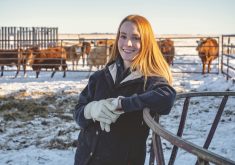At the University of Saskatchewan’s College of Agriculture, Dean Mary Buhr doesn’t spend much time fretting over whether women are being accepted in the agriculture industry.
Long gone are the days when female students were seen as a novelty or as brave trailblazers.
These days, they’re just students, and Buhr is surrounded every day by a cohort of smart young women. In almost every class, in fact, they’re in the majority.
“We’re not just seeing this in certain areas, or certain disciplines,” Buhr says. “It’s across the board, including things like our bachelor of science in agriculture, where more than 60 per cent of the students are female.”
Read Also

Building a farm legacy that outlasts you
A farm’s legacy isn’t just about the land; it’s also about the values and the impact that continue long after the current owner has stepped away.
It’s actually the numbers of this core science-based program that paint the most interesting picture of the evolving role of women in agriculture, Buhr says. Back in the early ’70s, about five per cent of the students were women. By the late ’70s and early ’80s, that had grown to about a third of the students, increasing through the years until it reached parity in the late 1990s.
Then around the turn of the millennium, women entered the majority, and over the last five years, their numbers have remained largely constant at 60 to 63 per cent.
In no small part, this evolution in the agriculture colleges has mirrored societal developments that have seen more young women pursuing better education and opportunities.
“In many of the other degree programs within the college, the numbers are even higher,” Buhr says. “For example, our renewable resource management program has a higher percentage of female students. Veterinary medicine is usually between 80 and 90 per cent female, which is typical for any of the caring professions like medicine or nursing as well. Even agriculture economics, which tends to be more male, has about 40 per cent female students.”
For an industry that’s quietly still thought of as an old boys’ network, this is likely going to mean significant changes going forward, says one early trailblazer for women in agriculture.
Alberta-based farmer, author, and mentor Brenda Schoepp, a 2012 Nuffield agricultural scholar, has studied the role of gender in agriculture around the world and here at home. She says women are taking their place as farmers in their own right, and she’s glad to say it’s not just a marginal activity anymore.
“I think the most important thing to realize is that this is something we are doing,” Schoepp says. “We’re not getting there in agriculture. We’re already here. Now we’re seeking the information and support to grow our businesses and farms.”
Back to the farm?
What’s driving this flood of women into agriculture? In most cases it’s rational decision-making by the young women coming into the programs, though it may not be something they put in words.
“We’re talking about young adults, so I’m not sure how carefully any young person thinks about these things,” Buhr says. “But I do think that when they look around at their peers, young women quickly realize that if they want opportunities, they’re going to have to get an education. For young men, there are alternatives, but most young women won’t be going to the oil industry and earning $30 right out of high school. They see their peers working in a clothing store for minimum wage.”
One of the most interesting questions is where these young women will find themselves after their education. In recent years, women have become a more and more common sight in almost every facet of the industry, from chemical reps to extension agents. But back on the farm, you have to wonder if their progress has been as strong.
A recent Statistics Canada snapshot publication delved into gender balance on Canadian farms and found that women still lag behind. The numbers have been increasing since the agency started tracking them in 1991, but even so only 27.8 per cent of all farm operators are women, and even that number masks the true picture. “… women continue to be rare as sole operators, even though they made up about 40 per cent of operators on multiple-operator farms,” the report read in part.
The conclusion would seem to be, that yes, women do farm — but often only if there is also a man in the picture.
Is this permanent, or will these numbers slowly shift as well? Buhr is convinced they will. More and more she’s seeing women coming into the program, studying agricultural science, and returning to the farm.
“They’re going back to the farm to work with their parents — actually in a lot of cases, to work with their dads,” Buhr says.
In a lot of ways, that’s just bringing Canadian agriculture back into alignment with trends around the globe, says Schoepp.
“Most of the food produced around the world is produced by women,” Schoepp says. “For whatever reason, it’s a very North American thing for agriculture to be so male.”
Schoepp says women bring a lot to the table, including different ways of looking at and solving problems, and there is hard economic data suggesting any industry, including agriculture, is best served when both men and women sit around the table working on decisions.
“When you reach gender balance, you generally see about a 40 per cent increase in return on investment,” Schoepp says. “Men and women problem solve in different ways, and it’s just better if you have all viewpoints.”
In some business areas, Schoepp says, women globally seem to have particular strengths, such as in value adding.
That means a huge chunk of Canada’s farm future could have a female face.
Buhr, who grew up in Manitoba, then worked in Ontario before coming to Saskatchewan, says this move of women in agriculture could, at least partly, mirror the unique farm culture.
“We’re not telling our children ‘You’re a boy,’ or, ‘You’re a girl,’” Buhr says. “We’re saying, ‘You’re a kid. And it’s time to do your chores.’”
Remaining challenges
It’s not a perfect world, of course. Serious challenges remain for women in agriculture, although Buhr says the industry generally gets a passing grade. The major challenges it does have when trying to make the ag workplace work for women are challenges almost every industry is grappling with.
“There are issues around things like work-life balance and having both a family and a career,” Buhr says. “Those aren’t issues unique to agriculture.”
Schoepp agrees the world has opened up for women in agriculture, but says there are some remaining structural issues that must be addressed.
“There is an issue of availability of credit to grow our farms and businesses,” Schoepp says. “I do think we still have some challenges there.”
She cites a recent U.S. study that showed when men and women applied for farm loans, if the loan criteria — things like cash flow and available security — were equal, male farmers were still about 20 per cent more likely to get the loan than female farmers.
“This is something that is well documented around the world, whether you’re talking about a major bank or a village credit system,” Schoepp says.
There’s also the question of getting access to technical support for female farm operations, which tend to be smaller in scale, and therefore of less interest to agri-businesses that are more concerned about catering to the largest operators.
“That’s not necessarily strictly a female issue,” Schoepp says. “I think it’s an issue for smaller farmers, men and women alike.”
Buhr says if she’s concerned about a gender group these days, it’s actually young men, not young women, since the gender balance numbers suggest they’re being left behind in terms of higher education.
“You would think that what would happen is we would reach a point of parity, where numbers were more or less even,” Buhr says. “But that’s not what’s happening. In almost every case, young women are going to school more than young men. We as the ‘intelligensia’ are, somehow, failing to attract young men to higher education.”
This trend cuts a wide swath across the country and impacts everything from medicine to business, with just a few exceptions, like engineering and IT, where men remain in the majority. Some speculate this is because young men, especially in the resource-driven western economy, simply have other options that pay well without all that schooling.
“That might be true in Western Canada, but I’m not sure it is true of Eastern Canada, and this is something we’re seeing happen everywhere,” Buhr says.
Buhr says any trend that sees any group’s participation in higher education drop is a troubling one, not just for the group in question. “If we’re not attracting all the best candidates from all backgrounds into higher education, it’s a loss for society as a whole.”
Shared solutions
In 2012, when Brenda Schoepp attended the annual conference for that year’s Nuffield Scholar agriculture program, her mandate was to look at women in agriculture and how mentorship programs could serve them. The event was primarily male, and they were a bit skeptical.
“They asked me a lot of tough questions,” Schoepp says. “But in the end, what I realized is that they weren’t hostile toward the idea at all — they were just wondering, ‘What about us? Couldn’t we benefit from this too?’”
This is perhaps the central challenge of building equitable sex roles in Canadian agriculture — preventing it from devolving into an unwinnable us-and-them, he-says she-says battle, when instead the best solution will lay in working together and finding solutions that are better for everyone. Schoepp says nobody wants to see women confined to a pink ghetto.
“I don’t think women want to be seen as a special-interest group, or to be isolated in any way, or segregated as a population,” Schoepp says. “We want equal recognition and access to the information we need to take our farms and businesses to the next step.”
In fact, in many cases, some of the strongest supporters of the changing role of women in agriculture are the men who farm, Schoepp says. That’s because they’re not frozen in amber in some sort of 1950s sitcom world, but have evolved themselves, often at a pace that would surprise many from outside of agriculture, who view the industry as quaint and somehow outdated.
“There are men in agriculture now who are also caregivers and struggle with feeling divided and pulled in many different directions,” Schoepp says. “These are no longer women’s issues and men’s issues. They’re human issues.”
Schoepp added that her ongoing exposure to young farmers of both sexes has been especially heartening, because they’re proving to be an innovating group who are interested in doing things a bit differently both personally and professionally.
“They’re very passionate about farming, their communities, and their industry,” Schoepp says.
Loud and proud
If Canadian women in agriculture suffer from any serious shortfall, it’s being overly modest.
Even as more and more of them have entered the business and assumed more senior roles, they hesitate before stepping into the spotlight and claiming the glory, no matter how well deserved. At times that’s modesty and at other times, it’s a struggle to get credit for their ideas and work.
“I’m sometimes reminded of the old cartoon where the chairman of the board is addressing a woman and says, ‘That’s a great idea Ms. Jones. Perhaps one of the men would like to suggest it,’” she says. “If that’s happened to me once, it’s happened a thousand times, and I’ve found myself wondering, ‘Did I say that right?’”
That won’t change unless women are willing to be equally proud and unapologetic about their presence in the industry, Schoepp says.
“Sometimes I think it’s a Canadian problem,” Schoepp says. “We’re a bit too polite and a bit to unassuming.”

















